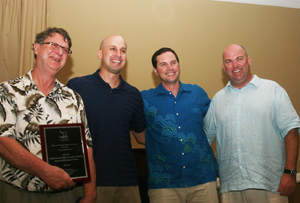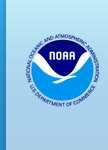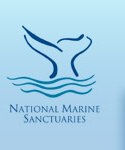With Help from Community and Partners, NOAA Charts Course for Sanctuary’s Next 25 Years
November 2015
NOAA officials thanked their partners and the community for making the Florida Keys National Marine Sanctuary a success as they marked their 25th anniversary with a dinner and festival hosted this weekend by the National Marine Sanctuary Foundation.
The sanctuary was created on November 16, 1990 to protect the only living coral barrier reef in the continental U.S., extensive seagrass beds and historic shipwrecks.
 (Left to right) John Hunt, Program Administrator of the Florida Fish and Wildlife Research Institute lab in Marathon, Florida, is congratulated by Florida Department of Environmental Protection’s Coastal Office Director Kevin Claridge, Acting Director of the Office of National Marine Sanctuaries John Armor, and Florida Keys National Marine Sanctuary Superintendent Sean Morton.
(Left to right) John Hunt, Program Administrator of the Florida Fish and Wildlife Research Institute lab in Marathon, Florida, is congratulated by Florida Department of Environmental Protection’s Coastal Office Director Kevin Claridge, Acting Director of the Office of National Marine Sanctuaries John Armor, and Florida Keys National Marine Sanctuary Superintendent Sean Morton.Through a recorded video message, U.S. Senator Bill Nelson congratulated the sanctuary at a partner’s dinner hosted by National Marine Sanctuary Foundation on Saturday. The Senator noted that the sanctuary kept the coral reef and over 6,000 species of marine life healthy and safe from “the ravages of offshore oil drilling.”
NOAA Chief of Staff Renee Stone spoke at the Saturday dinner, hailing the Florida Keys as an internationally recognized marine protected area and noting its role as a pioneer among national marine sanctuaries.
In addition to banning oil development, the Act that created the sanctuary designated the first “Area to Be Avoided” (ATBA) to prevent major ships from coming dangerously close to the reef line and formed the Water Quality Protection Program, the first program to address water quality issues in a national marine sanctuary. The sanctuary’s network of marine zones was the first of its kind in the United States when it was implemented in 1997. Florida Keys was also the first sanctuary to create a community-based Sanctuary Advisory Council made up of volunteers representing all aspects of local resource users and marine interests. Today, all national marine sanctuaries have similar advisory councils.
“The community-based approach to ocean conservation developed in the Florida Keys sanctuary over the last 25 years has inspired action in other national marine sanctuaries and marine protected areas around the world,” said John Armor, Acting Director of the Office of National Marine Sanctuaries.
State Partners Praised
At Saturday’s dinner, Armor recognized John Hunt, Program Administrator of the Florida Fish and Wildlife Research Institute lab in Marathon, Florida, with the Office of National Marine Sanctuary’s biennial “Outstanding Partner” award for 2014-2015. Since the sanctuary’s inception, the state institute has been at the forefront of research on corals, fish, lobster, and other natural resources mutually managed by the state and the sanctuary.
“The science provided by the state, under John’s leadership, has been critical for making careful management decisions in the face of complex issues,” said Sean Morton, sanctuary superintendent.
Provost and Executive Vice President of Florida International University (FIU) Kenneth Furton also emphasized the importance of science for managing the sanctuary’s resources. FIU has a partnership with the sanctuary to support their science, operations, education and administration.
“A lot of history and hard work went into our designation and it is certainly cause for celebration,” said Morton, “We are here because of the support of our partners, the hard work of the staff and Advisory Council members and the cooperation of the community as a whole.”
“The State of Florida is pleased to celebrate the many accomplishments of the sanctuary designation over the past 25 years," said Kevin Claridge, director of the Florida Department of Environmental Protection’s Coastal Office. “The successes in the sanctuary are due to many dedicated local, state and federal partners working together towards common goals.”
Mooring Buoy Campaign Launched
Morton shared news on Saturday night that the National Marine Sanctuary Foundation is teaming up with FURY Water Adventures, one of the sanctuary’s Blue Star Operators, to kick off a year-long campaign to raise awareness and funds for their mooring buoy program. The Blue Star program is a business partnership run by the sanctuary to recognize dive and snorkel businesses that have made a commitment to promote low-impact practices.
The fundraising campaign will help offset maintenance costs, which can average a thousand dollars annually per buoy. Mooring buoys are another conservation tool developed in the Keys to limit anchoring in sensitive coral habitats. Today, the sanctuary maintains about 500 mooring buoys as part of an overall network of almost a thousand buoys, which also includes marker buoys and information buoys.
More information about the fundraiser can be found on the Foundation’s website: http://nmsfocean.org/mooring-buoys.
“Twenty-five years ago the situation in the Florida Keys looked bleak, with threats from looming oil development, deteriorating water quality, major ship groundings, and massive coral bleaching...but the stars were in alignment and we managed to achieve many ‘firsts’ so we could preserve this magical place for the next generation,” said Billy Causey, the sanctuary’s first superintendent and current Southeast Regional Director for the Office of National Marine Sanctuaries, who concluded the Saturday dinner with a toast.
Learn more about the history of the sanctuary at this Timeline of Historic Milestones and Events.
Florida Keys National Marine Sanctuary protects 2,900 square nautical miles of critical marine habitat, including coral reef, hard bottom, sea grass meadows, mangrove communities and sand flats, as well as shipwrecks and maritime heritage resources. NOAA and the state of Florida manage the sanctuary. Visit us at http://floridakeys.noaa.gov, find us on Facebook and follow us on Twitter.


